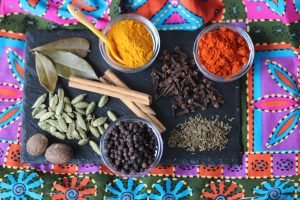 Fall is a time of transition and signals the coming of cooler weather. It is an important time to prepare the body for the cold months ahead by nourishing it deeply. This is especially true this year with our worries about the pandemic.
Fall is a time of transition and signals the coming of cooler weather. It is an important time to prepare the body for the cold months ahead by nourishing it deeply. This is especially true this year with our worries about the pandemic.
You might also find as we transition into fall that you are craving carbs more than you normally would. This is normal. As the light starts to fade, your serotonin may be decreasing and eating carbs may help you to feel better. But it is important to focus on slow carbs like veggies, grains and legumes with some healthy fat and protein instead of refined carbs and sugar.
 When it comes to seasonal eating, practicing ayurvedic habits make sense. Ayurveda, one of the oldest continually practiced health system in the world, translates into “knowledge of life”. Based on the idea that disease is due to an imbalance or stress in a person’s consciousness, Ayurveda encourages a certain lifestyle and natural therapies to regain a balance between the body, mind, spirit, and the environment.
When it comes to seasonal eating, practicing ayurvedic habits make sense. Ayurveda, one of the oldest continually practiced health system in the world, translates into “knowledge of life”. Based on the idea that disease is due to an imbalance or stress in a person’s consciousness, Ayurveda encourages a certain lifestyle and natural therapies to regain a balance between the body, mind, spirit, and the environment.
In ayurvedic health practices, the autumn time is seen as the season that is predominantly of the air element. Autumn is dry, rough, windy, erratic, cool, subtle, and clear. The idea is to balance the season with foods that have opposite attributes. Or foods that are moist, smooth, and warming.
In the early fall, try cooking with the harvest of more astringent and bitter foods to help to expel residual summer heat. These foods include cranberries, cold hardy dark leafy greens, eggplant, barley, apple, pear, quinoa, and legumes (peas, beans, and lentils), as well as tofu and other clean protein.
As the appetite grows and the weather gets colder you might notice a craving for sweet, moist, warming food such as such as root vegetables especially pumpkin and winter squashes. You may also find you have an appetite for moist grains like brown rice and oats. They are best cooked with a little extra water in this season. For fruit, include sweet or heavy fruits such as bananas, pomegranate, and mangoes.
Dried fruits, nuts and healthy oils may be something you find yourself craving at this time of year. This is natural as your appetite increases in the colder months.
 Along those same lines, warming spices such as cinnamon, ginger, cumin, fennel, coriander, clove, and turmeric help the digestive system make a shift from hot to cool weather. Herbs that can also be helpful to your digestion include sage, rosemary, and thyme.
Along those same lines, warming spices such as cinnamon, ginger, cumin, fennel, coriander, clove, and turmeric help the digestive system make a shift from hot to cool weather. Herbs that can also be helpful to your digestion include sage, rosemary, and thyme.
Also consider reducing dry foods such as chips and crackers, coffee and/or other high caffeine drinks, and raw foods during this season. As we head into the holidays be conscious of your desire for sugar. Make sure you are practicing mindfulness to make choices that are good for your health and wellbeing.
Eating seasonally in the fall helps to support our bodies grounding and healing abilities. But you may have also noticed that all the foods that are recommended to balance your body as we move into the cold weather are foods that are most abundant in the fall. We are so fortunate to live in the Monadnock region of New Hampshire with its many local farmers and great fresh food options. Be sure to explore local resources wherever you may live. You may be surprised to learn there are more healthy food options available.
Beyond the health aspects, local and seasonal food just hands down tastes better. Generally, what affects nutrients also affects flavor. Food that travels a long way from its origin loses its essence every step of the way. And when it is picked early before it is ripe, the food never gets a chance to develop its full flavor potential.
Seasonal food is generally less expensive than food that needs to be imported from other areas of the country or even the world. It’s costly to both our pocketbooks and the planet.
Enjoy the flavors of the season on your journey toward optimal health.

